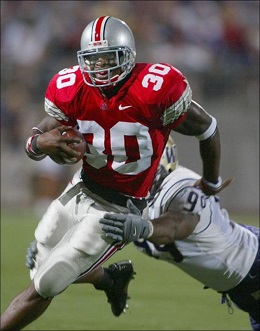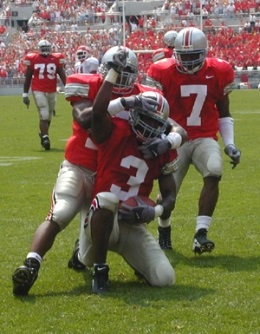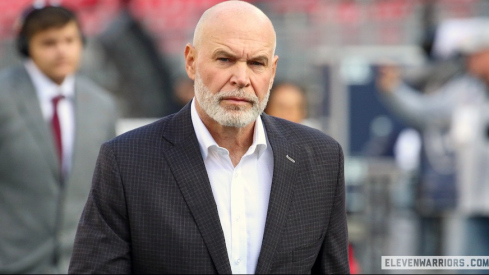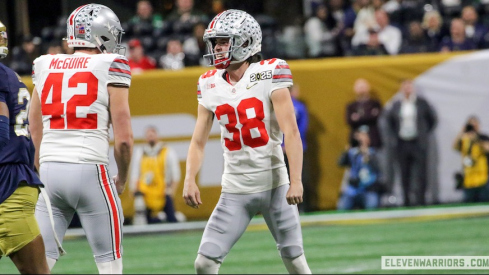For the Ohio State football program, 2001 was the year when the foundation was laid, the blueprints for future championships were drawn up, and the character of the Tressel regime was established. The Buckeyes finished third in the conference that year, behind Illinois and Michigan, but that does not tell the story of the season. 2001 was all about learning how to persevere through adversity, how to bounce back from tough losses, and how to win in tough environments.
 Ross scored two touchdowns against the Aztecs.
Ross scored two touchdowns against the Aztecs.The 2001 Buckeyes were coming off a year in which not only did they not live up to expectations, but the entire football program was black and blue. The character of the team had suffered in the last two seasons under John Cooper, to the point where a bowl game in which the team was supposed to represent both their school and their conference turned into a vivid illustration of what the phrase "mailing it in" really means.
It was going to be different this season. New head coach Jim Tressel had promised that the fans and followers of the program would "be proud of our young men" both on the football field and off of it. There is a school of thought that says toughness transcends the game and becomes part of who you are as a person. Someone who can overcome difficult obstacles on the field and in the gym will be well prepared to handle such obstacles in the classroom and life in general. And vice versa.
Tressel preached such values as head coach, and his team quickly learned what it meant to face adversity on the field and off of it. After a relatively easy win over Akron in the opener, the next game was postponed due to the 9/11 terrorist attacks in New York and Washington. For a brief time, football took a back seat to life and the adversity was national rather than personal.
Ohio State was originally scheduled to play San Diego State in game two on September 15. Instead, the two schools agreed to push the game into late October when both schools had an open date. So Ohio State's game at UCLA became game two on the season, and an uninspired effort left the Buckeyes on the short end of a 13-6 score.
OSU rebounded with a 27-14 road victory against Indiana, and then overwhelmed Northwestern 38-20 at home in a nationally televised night game. But in their Homecoming Game the next week against Wisconsin, the Buckeyes went flat and let a 17-0 second quarter lead waste away, eventually losing 20-17. The team could have used an open week at that point, but instead they had to play the re-scheduled game against SDSU.
San Diego State had not recently shown any sign that they could be competitive in a game with Ohio State. They had finished 3-8 in 2000 and came into Ohio Stadium on Oct. 20 with a 2001 record of 2-4 with one of the wins coming against Division I-AA opponent Eastern Illinois (ah those were the days, Aztec fans). As the game against Ohio State commenced, Buckeye fans settled in expecting an easy contest.
The Aztecs disappointed the crowd by going up early with a 29-yard field goal. Ohio State would quickly grab the lead back when reserve running back Lydell Ross busted into the end zone from two yards out. But freshman kicker Mike Nugent missed the extra point, always an ominous sign. This Ohio State team was learning, but they had not yet absorbed what the new coach was trying to impart to them, leading to uneven effort and inconsistent game results.
San Diego State drove to the Ohio State 1-yard line in the second quarter and from there running back Larry Ned managed to push the ball across the goal line. Their kicker, apparently influenced by Nugent, also missed the extra point. But he would make up for it later in the quarter, booting a 38-yard field goal to give the Aztecs a 12-6 lead. Ohio State failed to respond and they went into halftime trailing 12-6.
The wheels came off for SDSU in the second half, and their offensive woes killed whatever chance they might have had to pull off the upset. The Buckeyes forced turnovers on five straight Aztec possessions and converted that to 14 points to take a 20-12 lead. OSU was sluggish on offense themselves, but eventually they managed to take advantage of opportunities. After linebacker Fred Pagac Jr. recovered a fumble at the San Diego State 18-yard line, quarterback Steve Bellisari scored on a 4-yard run six plays later to give Ohio State their first lead.
 Derek Ross (#7 at right) had a pair of interceptions.
Derek Ross (#7 at right) had a pair of interceptions.On the next possession, OSU cornerback Derek Ross picked off a pass from SDSU quarterback Lon Sheriff and returned it all the way to the 5-yard line. Three plays later, senior running back Jonathan Wells scored on a 1-yard run to give the Buckeyes some breathing room. Lydell Ross closed the scoring in the fourth quarter with a 51-yard touchdown run, and Ohio State shut down the Aztecs from there to wrap up a 27-12 victory.
San Diego State would rack up 3 more losses after this one before defeating Wyoming in their season finale. Another 3-8 season spelled the end for Ted Tollner at SDSU and the end of his head coaching career overall. The lone bright spot was Larry Ned, who rushed for 1549 yards and 15 touchdowns on the season. He was drafted in the 6th round of the 2002 NFL draft by the Oakland Raiders, but never played for them and ended up playing for the Minnesota Vikings in 2003 and 2004.
Inconsistency and unrealized potential was a good summary for the 2001 OSU team, and it showed up again the next week as they wasted another big lead in a road loss to Penn State. The Buckeyes would finish the season with a 7-5 record, including a humiliating home loss to eventual Big Ten champion Illinois, a rousing 26-20 victory at Michigan, and a deflating 31-28 loss in the Outback Bowl against South Carolina.
This was a hard way to learn all of the character lessons that were necessary in order to build toughness, but it paid off the next season. In 2002, the team would go all the way to 14-0 and a BCS Championship. Along the way toward that achievement, they faced many tough obstacles and moments where their toughness and character were tested. They passed all of the tests, and the result was a season for the ages. All of the struggles had been worth it.

